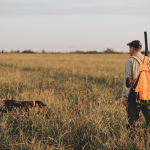Keep ’Em Safe: Cliffs, Cougars, and Coyotes
The three Cs of chukar country.
By eight years old, Jake had pointed and retrieved about three lifetimes worth of chukars, the beneficiary of boom years and lots of time engaged in the pursuit. He was tenacious, one of those dogs with too much tolerance for discomfort.
One of our favorite hunts in those days of Jake was what I called the “big butte,” its top slightly canted southward, which provided chukars perfect sunny wintertime habitat. A narrow, treacherously rocky canyon separated the butte from a much higher, cliff-rimmed escarpment that reached more than 6,000 feet into the desert sky and ran for miles north to south. On occasion, Jake and I would climb that ridge, coursing up a spine that led to a break in the rimrock to provide egress to the top, and then hunt northward over a broad plateau. One day I decided to explore southward along the ridge, and that’s when the trouble started.
Emerging from the steep slope through the gap in the rimrock, we turned south, where I enjoyed leg-saving flattish terrain for 200 yards before Jake got birdy. The situation alarmed me: He was flash pointing, moving cautiously, entranced by chukar scent, and trying to decipher the puzzle—just a few steps from the clifftop. The scent was blowing up from the canyon below the rimrocks. I eased toward him, gently urging, “Steady, steady,” and hoped to snap a lead on him so I could guide him away from the cliff. But before I could reach him, Jake figured out the scent, moved forward, and—to my horror—dropped over the cliff.
I was certain he was a goner; panic-stricken, I ran to the edge, dropped to all fours, and looked over. Jake was perched on a foot-wide ledge 10 feet down, and then he sprawled off that ledge and crashed another 15 feet to the bottom of the cliff. At the noise from falling shale and crashing brush, 30 chukars blasted into the air from the slope far below and disappeared down the canyon. I was amazed and intensely relieved that, somehow, Jake appeared to be uninjured.
That was 20 years ago, and I’ve never hunted over cliffs since. But cliffs are ubiquitous in chukar country and difficult to avoid. But avoiding them is the only way to keep dogs, and possibly hunters, from a perilous fall. Some years ago in Washington, an unfortunate chukar hunter made the news by falling off a cliff to his death. And on icy ground, I’ve taken enough falls to realize that one boot slip is all it takes to for a good bruising—add a cliff to the equation and such falls can be fatal. So, I always remind myself of this: No covey of chukars is worth me endangering my dog or myself. With that mantra in mind, and countless thousands of acres of chukar country out there, you can easily avoid the potential pitfalls, so to speak, of hunting above cliffs.
But you also need to know your ground. High-detail topographical maps, print or digital, show you places to avoid. Scrutinize maps for contour lines that squeeze so tightly together that they are no longer discernible as individual lines. Then do your scouting, because the maps won’t show everything, and neither will satellite views.
The south side of a huge dome that I hunt slopes precipitously into a deep creek canyon, and I avoid that side altogether because it’s studded with cliffs too small to show up on maps and sat images, but plenty high enough to pose a serious threat, whether you run on two legs or four. Viewed from across the canyon, the cliffs on that steep face appear as patches of dark brown stone amid sweeps of tawny cheatgrass, and they are numerous, all 20 to 80 feet tall, and 20 to 200 feet wide. It’s no place for dog or man and it’s loaded with chukars—they’re perfectly safe there, and as far as I’m concerned, they can stay that way. The north side of the dome slopes into a shallow, hanging valley that holds birds, and beyond that, three separate points loom out over the valley, each providing acres and acres of prime south-facing winter chukar habitat—more than enough good ground to content me without taking unnecessary risks.
In steep, rugged country, retrieving downed birds poses the biggest risk to pointing dogs, especially the enthusiastic retrievers among them—which means most chukar dogs. Eager and hot with scent, a dog can easily plunge off a cliff in steep terrain; even a modest cliff, a few feet high, etched into a precipitous slope is a launch ramp to injury. It falls on the hunter to be aware of the risks—if the retrieve will be perilous, don’t take the shot; if you do drop a bird down a treacherous slope, assess the situation before releasing the dog to retrieve—often you can guide a dog (particularly a young or inexperienced dog) to a better route down, and once there, the nose will do the rest.
Finally—and this goes for every dog whether a pointer or a pug—flawless recall is critical. Recall is the command that can save your dog’s life. Whether hot on the scent trail or bounding up the mountain eager to get the day started, my dogs must always heed a recall, and many times I’ve whistled a dog back from what I deemed to be dangerous ground.

Expert retrieving dogs are critical to bringing every bird to hand in hard country, but conscientious chukar hunters never release a dog to retrieve without knowing what kind of ground the dog must navigate. Experienced chukar dogs avoid cliffs, but enthusiastic youngsters are best led to a safe route if a downed chukar falls over a cliff of any size. Photo by John Shewey
So, cliffs are easy to deal with through avoidance and dogged adherence to the mantra that no bird is worth endangering your dogs, as well as unfailing recall. And that recall command is critical with the other two Cs of chukar country, both of which come with speed and cunning. Coyotes are rarely in and of themselves dangerous to hunting dogs; problems arise when dogs chase coyotes. But cougars can pose a very real threat to bird dogs—a few years ago, a hunter in Oregon had to endure the sight of his beloved spaniel being carried off over a far ridge by a big mountain lion. The biggest threat from cougars is just that—a wide-ranging pointing dog, intent on the pursuit of chukars, happens upon a cougar that is also in hunt mode. And that’s the cat you won’t see coming.
A decade ago, Forrest Maxwell and I were working our way up a gently sloping CRP field to reach a high ridgeline beyond. The dogs had veered into what we called “The Patch,” which was about two acres of old-growth sagebrush framing a shallow draw amid acres and acres of CRP and wheat stubble. The Patch often held chukars, and we’d let the dogs hunt it while we walked along the high edge. We were amazed that morning to watch a menagerie emerge from the far side of The Patch: first a deer, then a coyote, and finally a cougar. In that situation, the cougar is bent on escape and poses no threat unless the dogs give chase (they didn’t, because of that flawless recall along with no-chase training, to be discussed shortly). But if that cougar was in hunt mode and hadn’t heard or seen or smelled us coming, a dog might have sated its appetite.
Avoiding cougars is the best policy but also the most difficult because they are so secretive. I use three strategies to try to keep my dogs away from the big cats. The first strategy goes hand in hand with my aversion to cliffs. Cougars love hard country, and that includes cliffs and crags and canyons, all places I prefer to avoid anyway for the safety of my dogs.
Second, I always keep an eye peeled for cougar sign—tracks, scat, and kills. Lots of online resources can teach you to identify cougar tracks and scat. Kills (typically deer in chukar country) are usually dehaired and partially eaten and then buried (cached) to some degree, and the site tends to be tidy; coyote kills tend to be haphazard and messy, with no attempt at scratching brush and other detritus over the carcass to hide it. I came upon a cougar kill with Jake one year as we were hiking down a juniper-stuffed draw toward the road after a high-country hunt in middle-of-nowhere southeast Oregon. The deer carcass, frozen by the winter chill, was partially covered in pawed-up grass and brush. When the hair on Jake’s back stood on end, I leashed him and got the hell out into the open and away from there, my head on a swivel in case the cat decided to defend its kill. Again, it’s the cougar you don’t see that might cause a problem, although I know of one incident in which a pair of young mountain lions exhibited broad-daylight, out-in-the-open stalking behavior toward a hunter and his dogs.
Third, I talk to people, especially property owners, and professional trappers tasked with predator control in ranchlands in the West. When I started hunting a big parcel of canyon-carved private property in the 1990s, the landowner told me he hadn’t heard of a cougar in the area for years. His notion was largely confirmed by a contract trapper who worked with the U.S. Department of Agriculture Animal and Plant Health Inspection Service (APHIS), Wildlife Services program. These “government trappers” as they are known, can provide useful information. Contact details for state APHIS offices are available at www.aphis.usda.gov/aphis/ourfocus/wildlifedamage/sa_program_overview/sa_contact/state-offices.
Paradoxically perhaps, if hunting dogs chase a cougar, they aren’t likely to be imperiled unless they unluckily corner the cat within reach, but if your dog chases a coyote, the primary risk comes from the chase itself, not the animal. Coyotes are extremely swift when properly motivated—such as when being pursued by a dog that’s nearly as fast. Years ago, I watched a young pointing dog jump a coyote, and the high-speed chase quickly covered a quarter-mile; it ended when the coyote ducked under barbed-wire fence and the dog crashed into the fence. Luckily, the lacerations weren’t serious; it could have been much worse.
The problem with both cougars and coyotes is that it’s difficult to use the e-collar training protocols you would use to train dogs not to chase deer and other common game. It’s not like you can go find a cougar to use as an unwitting training partner in the way you might introduce your dog to deer and deer scent for the express purpose of setting up the dog to learn that chasing deer and following deer scent leads to stark discomfort. Some dogs need only be trained on deer and they understand not to chase other animals; but many dogs differentiate, and training them not to chase deer doesn’t necessarily train them not to chase coyotes, for example—and coyotes are ubiquitous in chukar country.
For that reason, I’m a big believer in basic obedience, taught early and often. My current Weimaraner, Java, needs nothing more than a no reminder from me to ignore deer and other undesirable denizens of chukar habitat (including porcupines). I taught her no when she was a pup, like most people, using positive reinforcement (yummy treats) to reward her for desisting with her interest in increasingly distracting temptations. The no (or leave it) command should be part of the basic obedience package for any hunting dog. As trainer Ken Walden wrote for an online site, “Prior to beginning any advanced field training, your dog must first master basic obedience. This is crucial to the success of field training as well as to the safety and well-being of your dog.”
E-collar anti-chase training and no/leave-it training are beyond the scope of this article, but the internet, along with excellent books and videos, are brimming with details. And such training is critical, as is flawless recall (by voice, yes, but also by whistle and/or e-collar signal or vibration, both of which reach beyond most human voices).
Chukar country can be mighty tough. But those rugged, dramatic landscapes are part of what make chukar hunting so appealing, so add a few basic protocols to account for the three Cs—cliffs, cougars, and coyotes—to your training and hunting strategies to keep everybody safe out there. And always remind yourself that no covey of chukars is worth endangering you or your dog.





